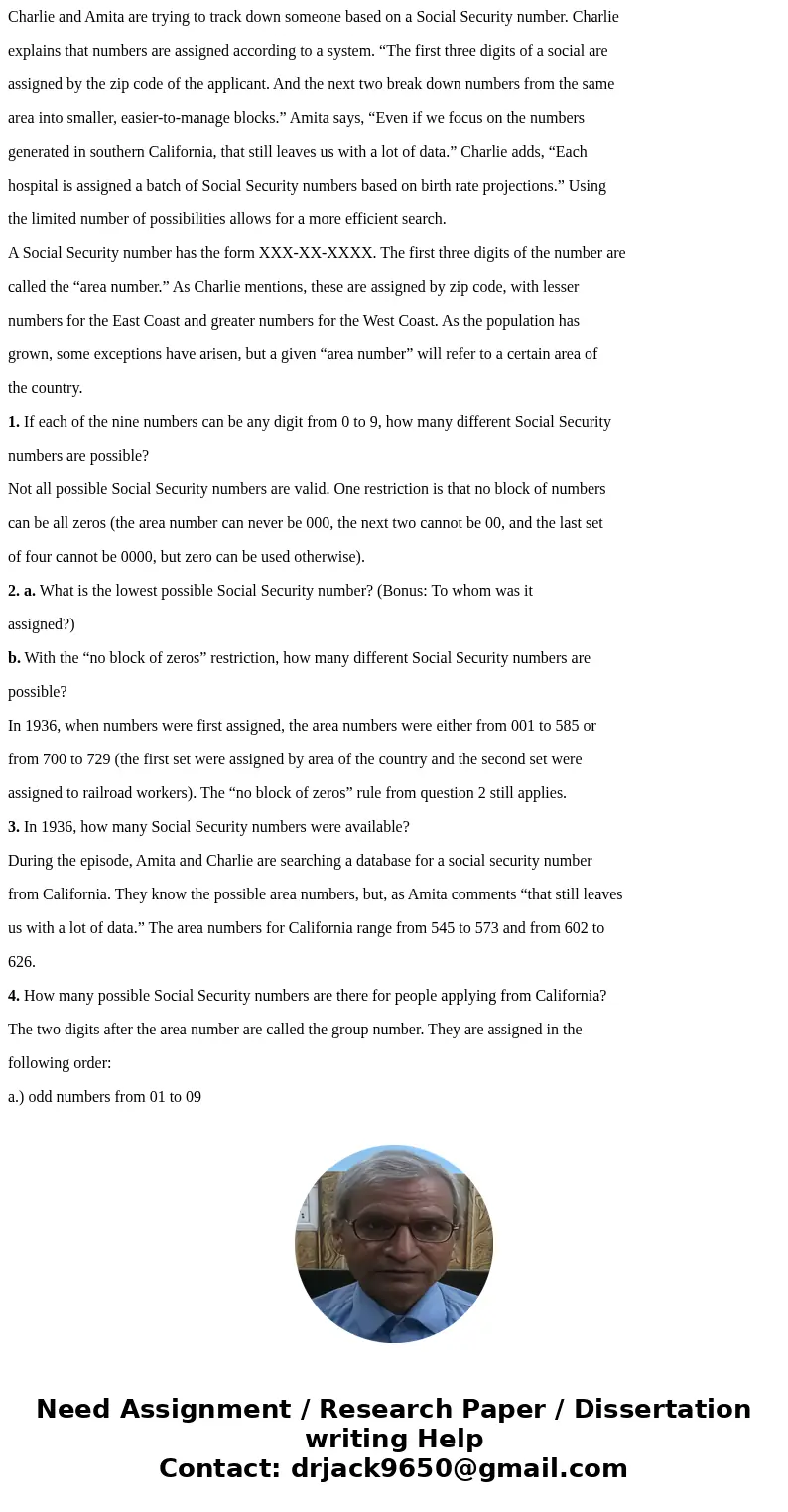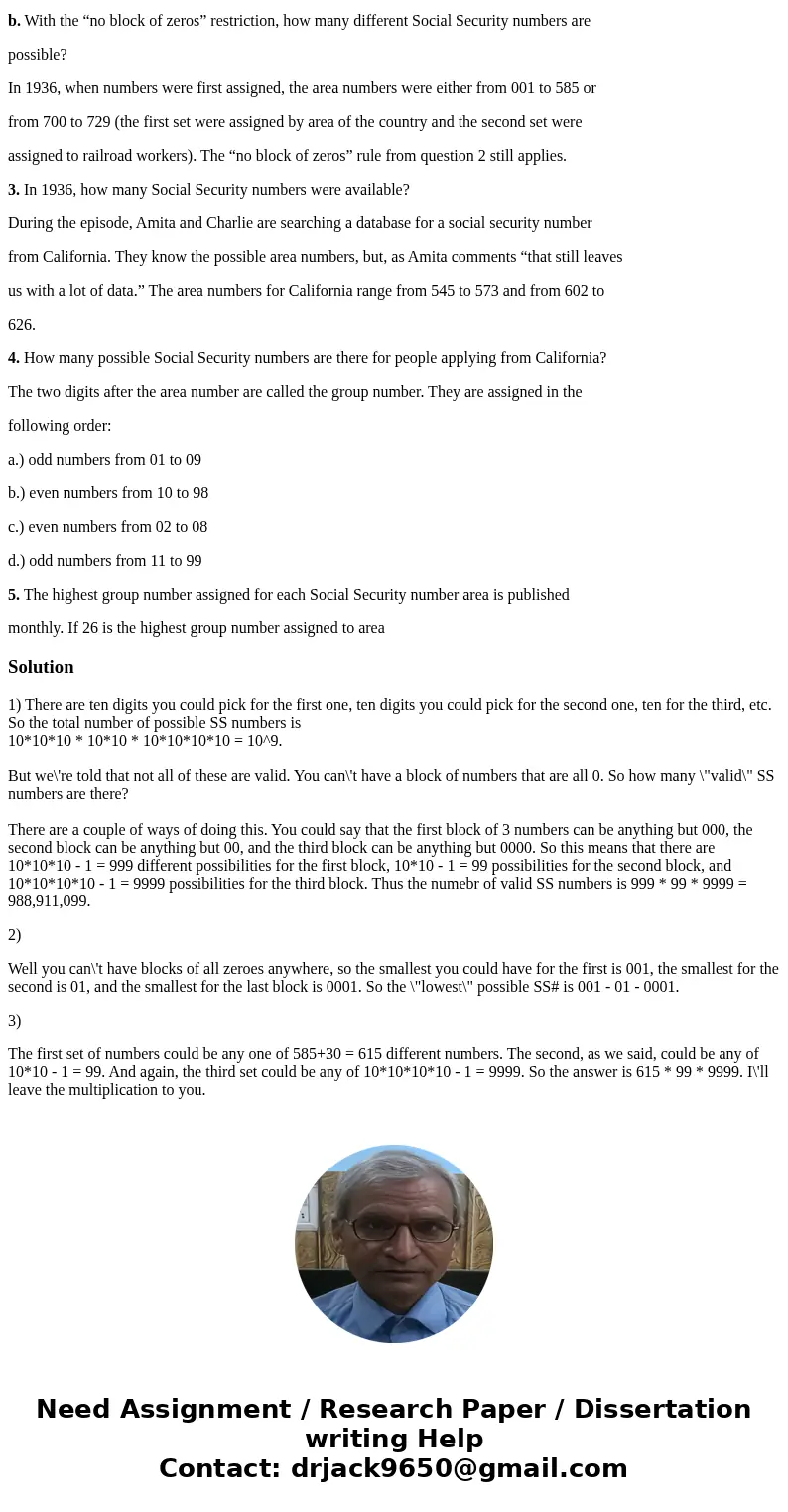Charlie and Amita are trying to track down someone based on
Charlie and Amita are trying to track down someone based on a Social Security number. Charlie
explains that numbers are assigned according to a system. “The first three digits of a social are
assigned by the zip code of the applicant. And the next two break down numbers from the same
area into smaller, easier-to-manage blocks.” Amita says, “Even if we focus on the numbers
generated in southern California, that still leaves us with a lot of data.” Charlie adds, “Each
hospital is assigned a batch of Social Security numbers based on birth rate projections.” Using
the limited number of possibilities allows for a more efficient search.
A Social Security number has the form XXX-XX-XXXX. The first three digits of the number are
called the “area number.” As Charlie mentions, these are assigned by zip code, with lesser
numbers for the East Coast and greater numbers for the West Coast. As the population has
grown, some exceptions have arisen, but a given “area number” will refer to a certain area of
the country.
1. If each of the nine numbers can be any digit from 0 to 9, how many different Social Security
numbers are possible?
Not all possible Social Security numbers are valid. One restriction is that no block of numbers
can be all zeros (the area number can never be 000, the next two cannot be 00, and the last set
of four cannot be 0000, but zero can be used otherwise).
2. a. What is the lowest possible Social Security number? (Bonus: To whom was it
assigned?)
b. With the “no block of zeros” restriction, how many different Social Security numbers are
possible?
In 1936, when numbers were first assigned, the area numbers were either from 001 to 585 or
from 700 to 729 (the first set were assigned by area of the country and the second set were
assigned to railroad workers). The “no block of zeros” rule from question 2 still applies.
3. In 1936, how many Social Security numbers were available?
During the episode, Amita and Charlie are searching a database for a social security number
from California. They know the possible area numbers, but, as Amita comments “that still leaves
us with a lot of data.” The area numbers for California range from 545 to 573 and from 602 to
626.
4. How many possible Social Security numbers are there for people applying from California?
The two digits after the area number are called the group number. They are assigned in the
following order:
a.) odd numbers from 01 to 09
b.) even numbers from 10 to 98
c.) even numbers from 02 to 08
d.) odd numbers from 11 to 99
5. The highest group number assigned for each Social Security number area is published
monthly. If 26 is the highest group number assigned to area
Solution
1) There are ten digits you could pick for the first one, ten digits you could pick for the second one, ten for the third, etc. So the total number of possible SS numbers is
10*10*10 * 10*10 * 10*10*10*10 = 10^9.
But we\'re told that not all of these are valid. You can\'t have a block of numbers that are all 0. So how many \"valid\" SS numbers are there?
There are a couple of ways of doing this. You could say that the first block of 3 numbers can be anything but 000, the second block can be anything but 00, and the third block can be anything but 0000. So this means that there are 10*10*10 - 1 = 999 different possibilities for the first block, 10*10 - 1 = 99 possibilities for the second block, and 10*10*10*10 - 1 = 9999 possibilities for the third block. Thus the numebr of valid SS numbers is 999 * 99 * 9999 = 988,911,099.
2)
Well you can\'t have blocks of all zeroes anywhere, so the smallest you could have for the first is 001, the smallest for the second is 01, and the smallest for the last block is 0001. So the \"lowest\" possible SS# is 001 - 01 - 0001.
3)
The first set of numbers could be any one of 585+30 = 615 different numbers. The second, as we said, could be any of 10*10 - 1 = 99. And again, the third set could be any of 10*10*10*10 - 1 = 9999. So the answer is 615 * 99 * 9999. I\'ll leave the multiplication to you.


 Homework Sourse
Homework Sourse